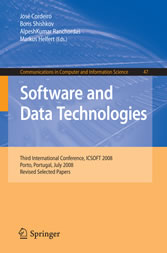Suchen und Finden
Mehr zum Inhalt

Software and Data Technolgoies - Third International Conference, ICSOFT 2008, Porto, Portugal, July 22-24, 2008
Preface
5
Organization
6
Table of Contents
10
Invited Speakers
10
User Defined Geo-referenced Information
12
Introduction
12
Hovering Information
13
Overview of the Hovering Information Concept
14
Analysis of the Hovering Information Concept
15
End-to-End QoS-Predictions’ Information Service
16
Basic Assumptions
17
Overview of the Concept and Service
17
Conclusions
18
References
19
Part I: Programming Languages
10
Extending the SSCLI to Support Dynamic Inheritance
20
Introduction
20
Background
22
Type Systems of Dynamically Typed Languages
22
Runtime Performance of Dynamically Typed Languages
22
Structural Reflection
23
$\Large{\textrevscr}{\small\textsc{Rotor}}$
23
The Object Model of $\Large{\textrevscr}{\small\textsc{Rotor}}$
24
Dynamic Inheritance
25
Design
25
Class-Based Model
26
Prototype-BasedModel
28
Implementation
29
The $setSuper$ Primitive Interface
29
Instance Manipulation
30
Class Manipulation
30
Current State of the Implementation
31
Conclusions
31
References
32
Scala Roles: Reusable Object Collaborations in a Library
34
Introduction
34
Objects and Roles
36
Compound Objects with Dynamic Proxies
37
Object Identity
39
Collaborations with Nested Types
40
Scala Roles in Action
41
Persons and Their Roles
42
Composite Design Pattern
43
Related Work
45
Conclusions
45
References
46
Part II: Software Engineering
10
Common Criteria Based Security Scenario Verification
48
Introduction
48
Scenario Language
49
Outline
49
Scenario Example
50
Verification of Scenarios
51
Rule
51
Evaluation
53
Rule Based on Common Criteria
54
Discussion
56
Related Works
56
Conclusions
57
References
57
A Software Infrastructure for User–Guided Quality–of–Service Tradeoffs
59
Introduction
59
Architectural Baseline
61
Quality–of–Service Tradeoffs
63
Evaluation of Usability
65
Coordinating Resource Usage
67
Evaluation
68
Adaptive Applications
69
Evaluation
69
Related Work
70
Conclusions
71
References
71
On the Multiplicity Semantics of the Extend Relationship in Use Case Models
73
Introduction
73
The Evolution of the Extend Relationship
74
The Interpretation of the Extension Point Concept
77
Discussion
81
Related Work
83
Conclusions and Future Work
84
References
85
Secure Mobile Phone Access to Remote Personal Computers: A Case Study
87
Introduction
87
Background
88
Security Issues
89
Proposed Security Model
90
Improving the Design
91
Implementation
93
Discussion
94
User Study
95
Related Work
97
Conclusions
98
References
99
Part III: Distributed and Parallel Systems
10
Understanding and Evaluating Replication in Service Oriented Multi-tier Architectures
102
Introduction
102
Replication in SOA
103
Basic Architecture
103
Replication
104
Replication Strategies
105
Categorization
105
Example Algorithm
108
Simulation
109
Simulation Architecture
109
Execution
111
Parameters
112
Selected Results
113
Related Work
114
Conclusions
114
References
115
Applying Optimal Stopping for Optimizing Queries to External Semantic Web Resources
116
Introduction
116
Performance and Scalability
117
The Search Test Stop Model
119
Preconditions
120
The Discrete Search Test Stop Model
120
Method
121
Cost Functions
121
Utility Distributions
121
Application
122
Evaluation
124
Performance
125
Web Services
126
Outlook and Conclusions
128
References
128
An Efficient Pipelined Parallel Join Algorithm on Heterogeneous Distributed Architectures
130
Introduction
130
Limitations of Parallel Execution Strategies in Multi-join Queries
131
Sequential Parallel Execution
132
Parallel Synchronous Execution
132
Segmented Right-Deep Execution
133
Full Parallel Execution
134
Parallelism in Multi-join Queries Using PDFA-Join Algorithm
134
Detailed Algorithm
135
Discussion
141
Conclusions
143
References
143
Part IV: Information Systems and Data Management
11
Declarative Business Process Modelling and the Generation of ERP Systems
145
Introduction
145
An Introduction to REA
147
An Object-Z Model
148
The REA Meta-model
148
The Runtime Model
150
A Domain Specific Language
151
Language Implementation
153
Automated Generation of Applications
154
Summary
156
References
157
Single Vector Large Data Cardinality Structure to Handle Compressed Database in a Distributed Environment
158
Introduction
158
Related Work
159
Existing HIBASE Compression Technique
160
Proposed Single Vector Large Data Cardinality (SVLDCS) Structure
161
Searching Technique
164
Explanation of the Searching Technique of (SVLDCS) Structure
165
Searching Time Analysis of SVLDC Structure
166
The Analysis of Storage Capacity of SVLDC Structure
166
Analytical Analysis of Storage Capacity Using Different Methods
167
Conclusions
169
References
170
Relaxed Approaches for Correct DB-Replication with SI Replicas
172
Introduction
172
Multiversion Histories
174
Generalized Snapshot Isolation
175
The Deferred Update Technique
177
1–Copy–GSI Schedules
180
Relaxing Assumptions
181
Conclusions
184
References
185
Measuring the Usability of Augmented Reality e-Learning Systems: A User–Centered Evaluation Approach
186
Introduction
186
Related Work
187
Evaluation Method and Procedure
189
Equipment
189
Participants and Tasks
190
Method and Procedure
190
Evaluation Results and Comparison
191
Answers to the Questionnaire
191
Most Mentioned Positive and Negative Aspects
192
Measures of Effectiveness and Efficiency
194
Conclusions and Future Work
195
References
196
Supporting the Process Assessment through a Flexible Software Environment
198
Introduction
198
State of the Art
199
EvalTOOL
201
Process Model Management
203
Application and Evaluation Model
203
EvalTOOL Application Example
205
EvalTOOL as Support to COMPETISOFT
207
Conclusions and Future Work
209
References
210
Part V: Knowledge Engineering
11
Increasing Data Set Incompleteness May Improve Rule Set Quality
211
Introduction
211
Blocks of Attribute-Value Pairs
213
Definability
215
Lower and Upper Approximations
215
LERS and LEM2
218
LEM2
218
LERS Classification System
219
Experiments
220
Conclusions
225
References
226
Anomaly Detection Using Behavioral Approaches
228
Introduction
228
Behavioral Approaches for Intrusion Detection
229
Why Standard Classification Rules Are Ineffective for Detecting Novel Attacks
230
Enhancing Bayesian Classification for Anomaly Detection
231
Using Zero Probabilities as Abnormal Evidence
232
Using Likelihood of Rare Attacks as Abnormal Evidence
233
Enhancing Decision Trees for Anomaly Detection
234
Decision Tree Classifiers
234
Decision Tree Adaptations for Anomaly Detection
234
Experimental Studies
237
Training and Testing Data Sets
237
Experiments on Standard/Enhanced Bayesian Classification Rule
238
Conclusions
239
References
240
Author Index
242
Alle Preise verstehen sich inklusive der gesetzlichen MwSt.







